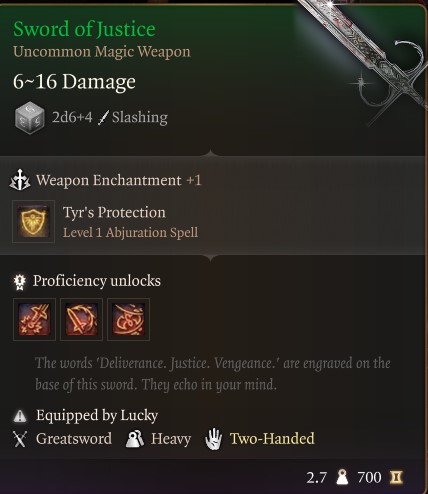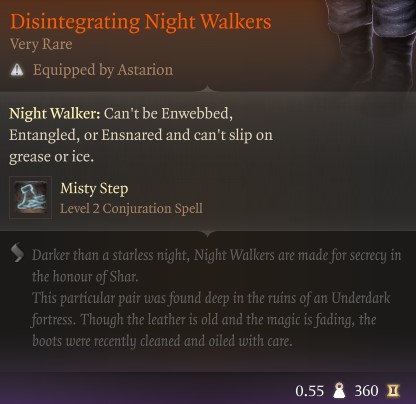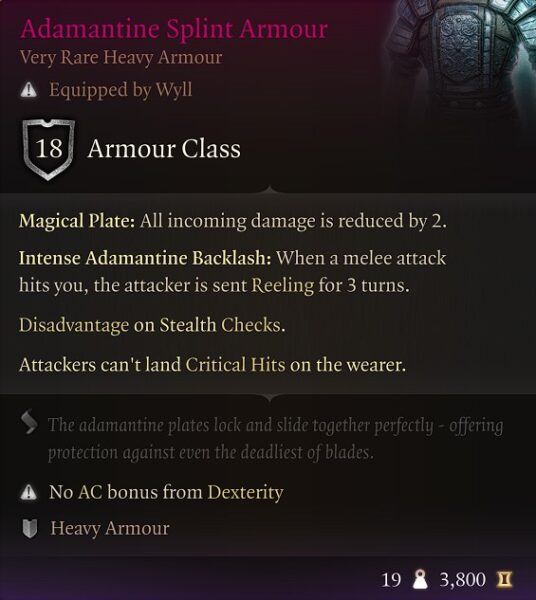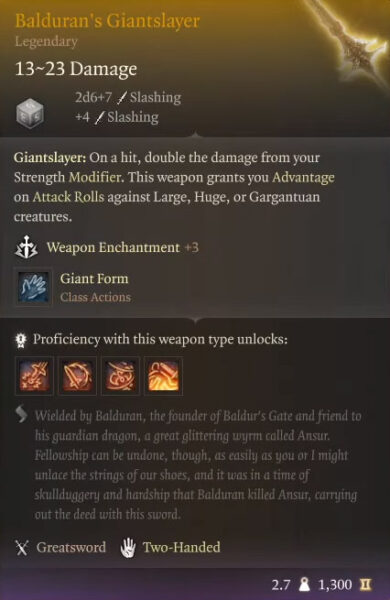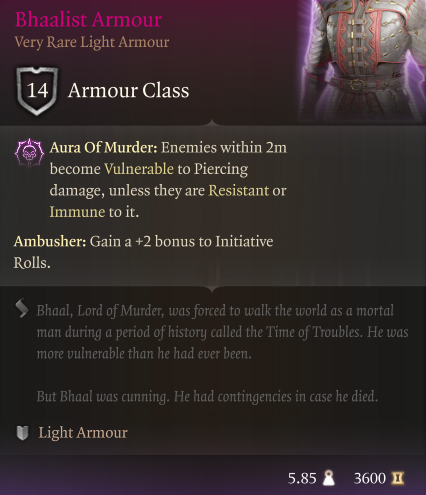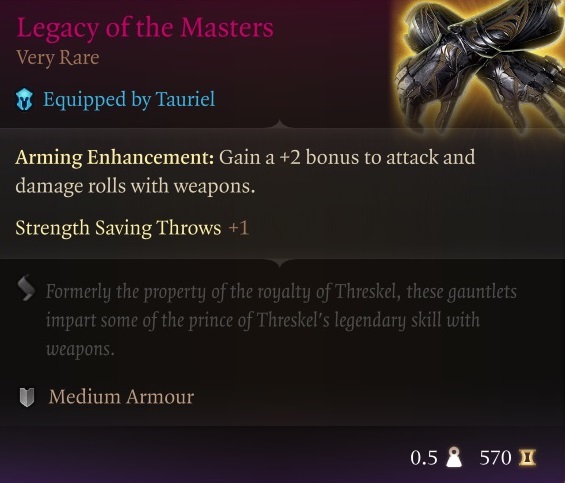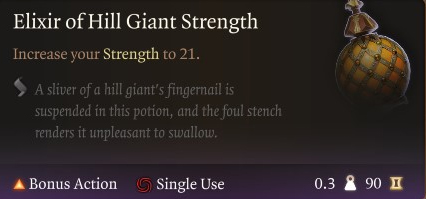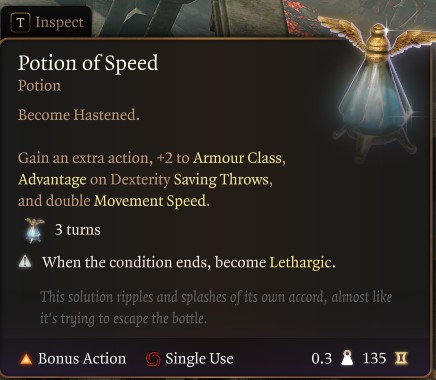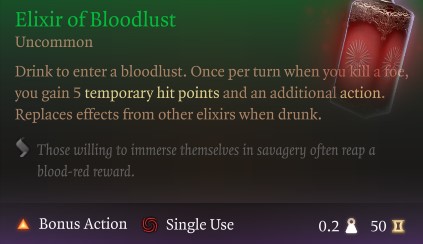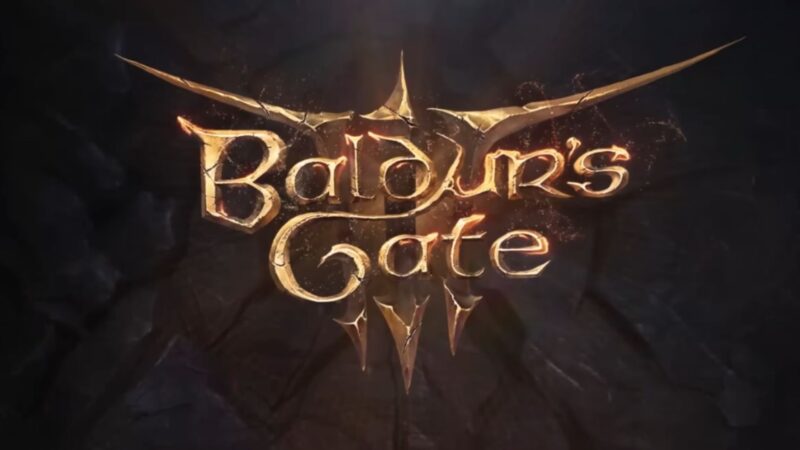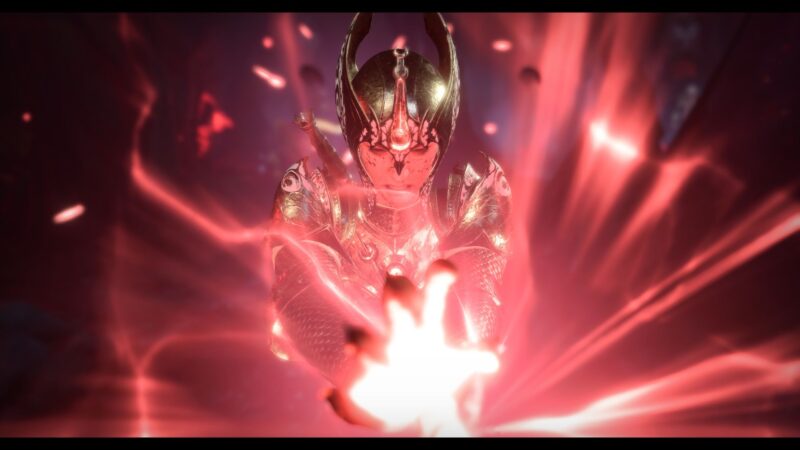This guide focuses on the key aspects of a Tactician Paladin build in Baldur’s Gate 3 (BG3), and how to use those powers to your advantage.

This build page has been updated for the Patch 8 version of Baldur’s Gate 3.
All About Tactician Paladin Build Guide
Tactician mode is the second highest difficulty in Baldur’s Gate 3, doubling camp resource cost and adding new layers of difficulty. Playing in Tactician gives you a unique challenge while allowing reloads of saves. This Paladin Tactician Build Guide gives you a complete layout of how to use, play, and progress effectively throughout BG3.

The Paladin is arguably the best build in Baldur’s Gate 3 due to its raw damage with Divine Smite and melee attacks. However, managing many spells, weapon actions, and choices can be difficult. Especially at the start of your Tactician campaign, spell slots will be limited, so you’ll need to make tactical decisions about using Divine Smite. This spell adds damage to melee attacks but consumes a spell slot each time. Therefore, we expect to collect everything from containers due to increased resting costs from 40 to 80. Let us walk you through all aspects of playing the Paladin, strong inside and outside combat in Tactician mode!
| Paladin Build Pros | Paladin Build Pros |
|---|---|
| High Damage | Complex |
| Good Survival | Spell Slot Starved |
| Utility Combat and Dialogue | Gear Dependent |
Tactician Paladin Changes in Patch 8 for BG3
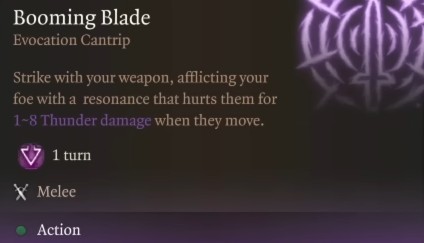
Patch 8 releases 12 new subclasses, spells, and cantrips giving the Paladin even more flexibility and damage potential. The two most important changes are Booming Blade cantrip and Wrathful Smite. Booming Blade cantrip can be taken to add more melee damage pure action every turn at no downside. The Hexblade Warlock gives you Wrathful Smite and other goodies with just one level selection. Therefore, you can make an even better multiclass Paladin setup to complete Tactician mode. Tactician Mode did buff some other NPCs:
- Balthazar can now cast Shield in Tactician Mode.
- In Tactician and Honour Mode, Malus Thorm will now use his Multiattack at 70% HP instead of 40%.
- In Tactician Mode, increased the spell level of Kar’niss’ Sanctuary spell from 4 to 5.
We will have al alternative build setup listed below for Paladin fans!
Features and Mechanics of Paladin
The following list presents all the essential Tactician Build Paladin Mechanics and Features in Baldur’s Gate 3:
- Class: Paladin
- Subclass:
- Vengeance
- Oathbreaker
- Background: Soldier
- Skills: Persuasion, Insight
- Ability Score
- Strength: 16
- Dexterity: 10
- Constitution: 14
- Intelligence: 8
- Wisdom: 10
- Charisma: 16
- Saving Throw: Strength, Constitution
- Armour Proficiency: Light Armour, Medium Armour, Heavy Armor, Shields
- Weapon Proficiency: Simple Weapon, Martial Weapons
Related:
How Tactician Difficulty Works
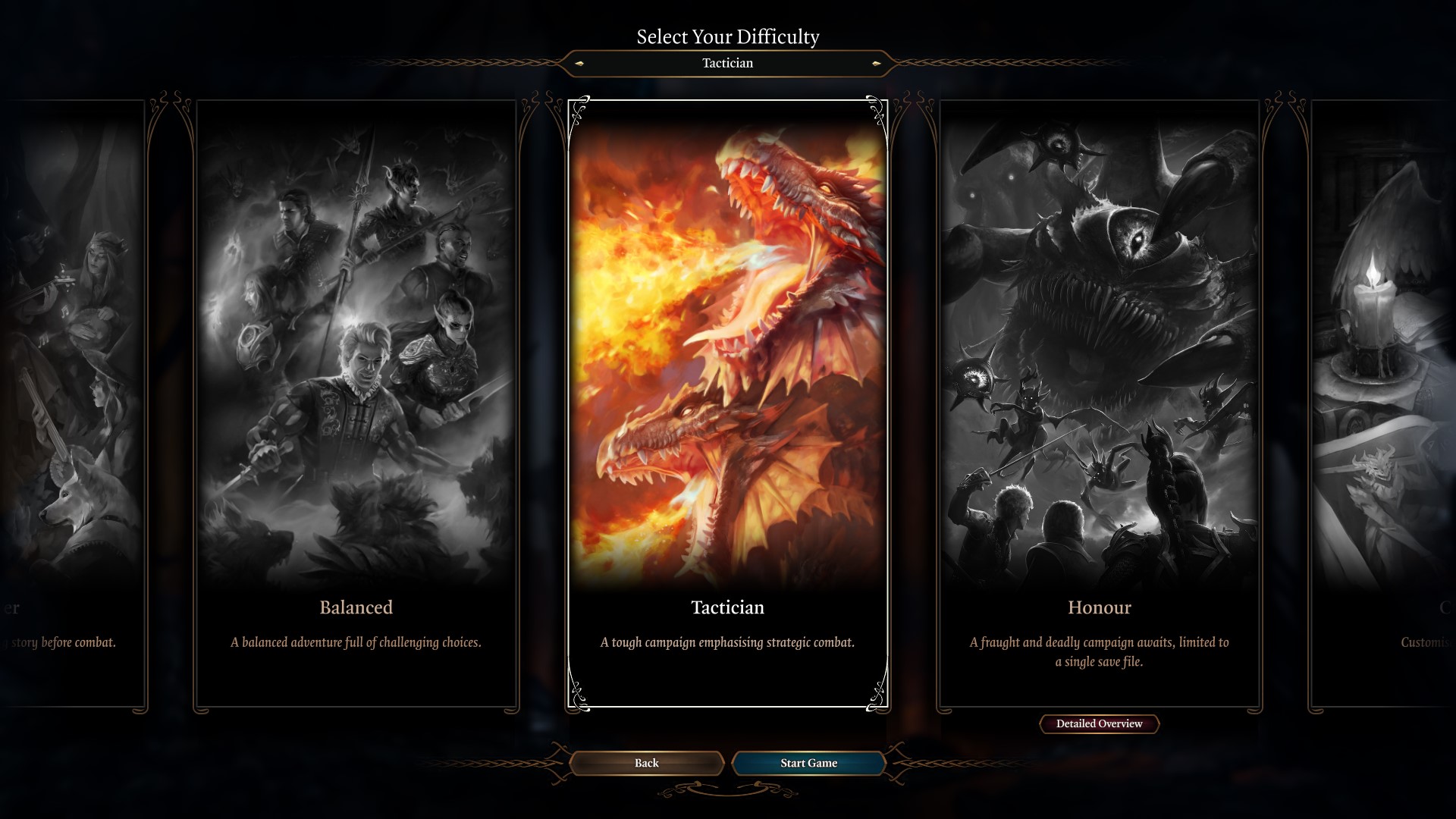
Tactician Difficulty in Baldur’s Gate 3 offers increased difficulty from Explorer and Balanced but less difficulty than Honour Mode. Tactician makes enemy NPC more difficult, increases camping supply cost, and uses more advanced spells. However, Tactician allows the reloading of saved files, which Honour Mode does not. Therefore, it’s less punishing but still challenging as you search for a more difficult campaign. Below is how Tactician Mode Difficulty changes in Baldur’s Gate 3:
- Increased Health for NPCs: maximum health increased by 20-30%, with certain “boss” enemies receiving even larger boosts.
- Enhanced Enemy Behavior: Enemies are more aggressive, often prioritizing spellcasters and attempting to finish off downed characters.
- Unique Abilities for Enemies: Some enemies in Tactician mode gain special attacks or passive abilities not found in other difficulties.
- Combat Modifiers: All non-party characters receive additional modifiers such as a +2 bonus to attack rolls and spell DCs, as well as other potential buffs like increased AC, resistances, better-saving throws, and unique modifiers.
- Resource Management: The Camp Supplies requirement for a Long Rest is doubled from 40 to 80.
- Economy Impact: The baseline attitude bonus for store discounts is reduced, making items more expensive to purchase and less profitable to sell.
Baldur’s Gate 3 offers five difficulty settings: Explorer, Balanced, Tactician, Honour, and Custom mode, which allows players to tweak various gameplay elements. Players can select a difficulty at the start of the game and change it at any time via the pause menu, with any changes to creature statistics taking effect immediately.
How to Play Paladin
The Paladin excels at damage at the expense of spell slots requiring constant resting. In Act 1, preserve your spell slots and melee attacks with Greatswords or mauls only for kill shots. You’ll gain more spell slots as you gain levels, freeing you to cast them for utility. Additionally, Smite spells like Thunderous Smite can be used from stealth to trigger the surprise status effect. This is a powerful way to gain an advantage in combat. Always try to use your bonus action with Divine Favour, a potion, jump, or poison on your weapon. Pre-buff each fight with a Cleric using Bless, apply an Elixir of Strength or Bloodlust, and attack from stealth when you know combat is imminent.
Below are some general tips on how to play the best Paladin build in BG3 Tactician:
- Loot Everything: You will need a lot of gold to buy consumables, potions, and ammunition so loot and sell constantly.
- Crafting: Elixirs and potions are vital, and you need to purchase materials when trading for crafting.
- Reach Level 6: Spend the early part of the game completing every quest to reach level 6 where your power dramatically increases.
- Sell Often: Your carrying capacity will be limited so sell often, and store excessive items in your traveler’s chest.
- Stealth: Start combat in stealth if at all possible to trigger the Surprise status effect.
- Consider Illithid Powers: While it can come with an altered appearance, the powers are powerful and can help you.
- Oils + Elixiris: Combine both oils/coatings and Elixir during combat for a dual benefit.
- Persuasion: Try to avoid combat through dialogue if possible.
Character Creation
| Category | Selection |
|---|---|
| Character | Origin – Custom Character |
| Race | Half-Orc |
| Class | Paladin |
| Subclass | Oath of Vengeance |
| Background | Soldier |
| Ability Score | STR: 16 DEX: 10 CON: 14 INT: 8 WIS: 10 CHA:16 |
| Skill Proficiencies | Persuasion, Insight |
Race Choice for Paladin
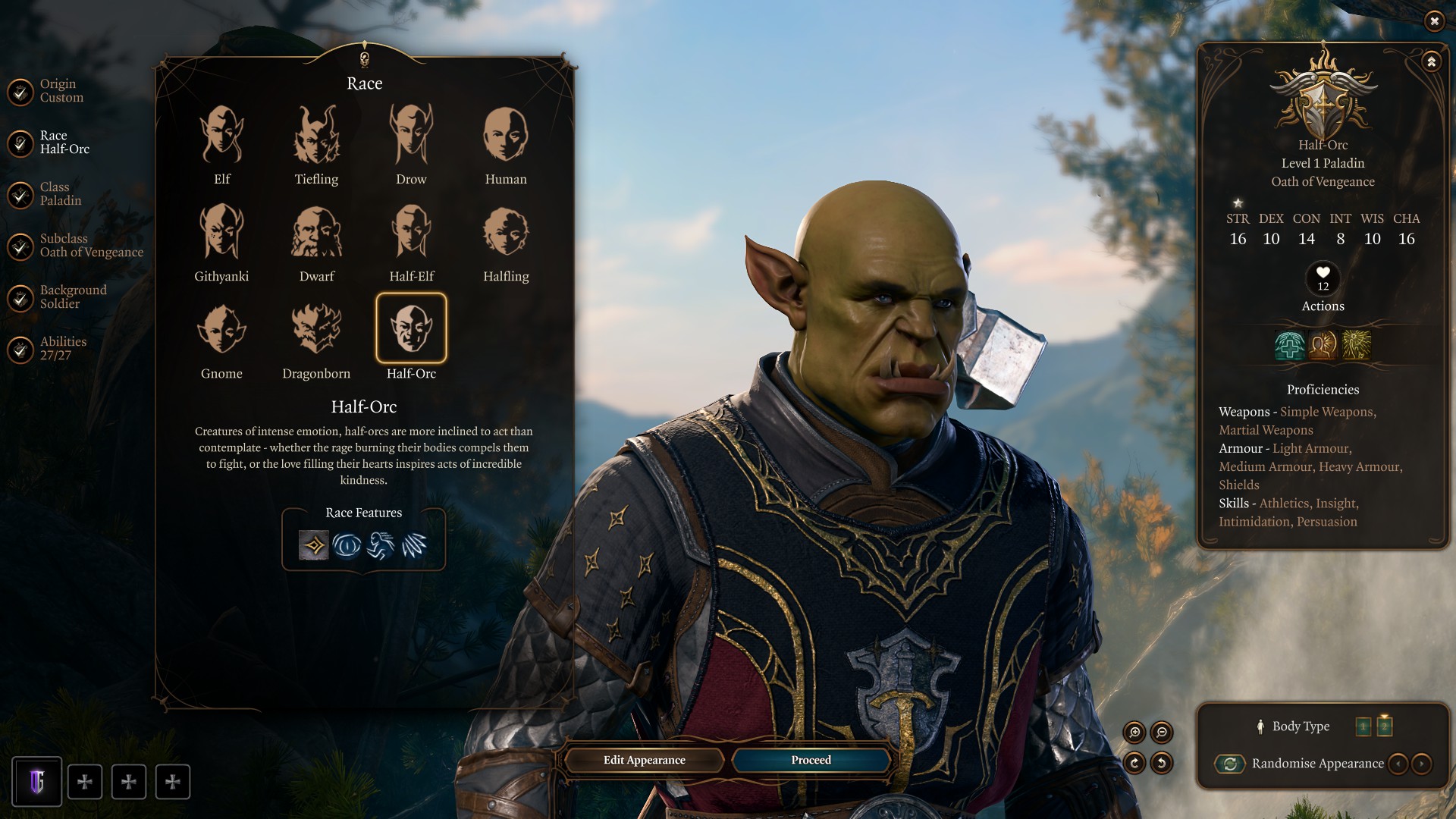
Half-Orc is the best racial choice for a Paladin on Tactician difficulty because of offensive and defensive racial bonuses. Half-Orc gained increased critical damage and restored 1 HP when knocked out. Therefore, they are the best from a pure combat perspective. Another option is Tiefling (Zariel) for Fire resistance and Thaumatury or Duergar Dwarf for invisibility and Enlarge spells.
Here is the best race choice for a Tactician Paladin build in Baldur’s Gate 3:
| Race | Features | Description |
|---|---|---|
| Half-Orc | Menacing Darkvision Relentless Endurance Savage Attacks | Extra dice on critical hit with melee and helpful when reaching zero HP |
| Zariel Tiefling | Darkvision Hellish Resistance Legacy of Avernus | Fire resistance and access to cantrips and spells |
| Duergar | Dwarven Combat Training Superior Darkvision Dwarven Resilience Duergar Resilience Duergar Magic | Access to Enlarge and Invisibility |
Paladin Best Subclass – Vengeance
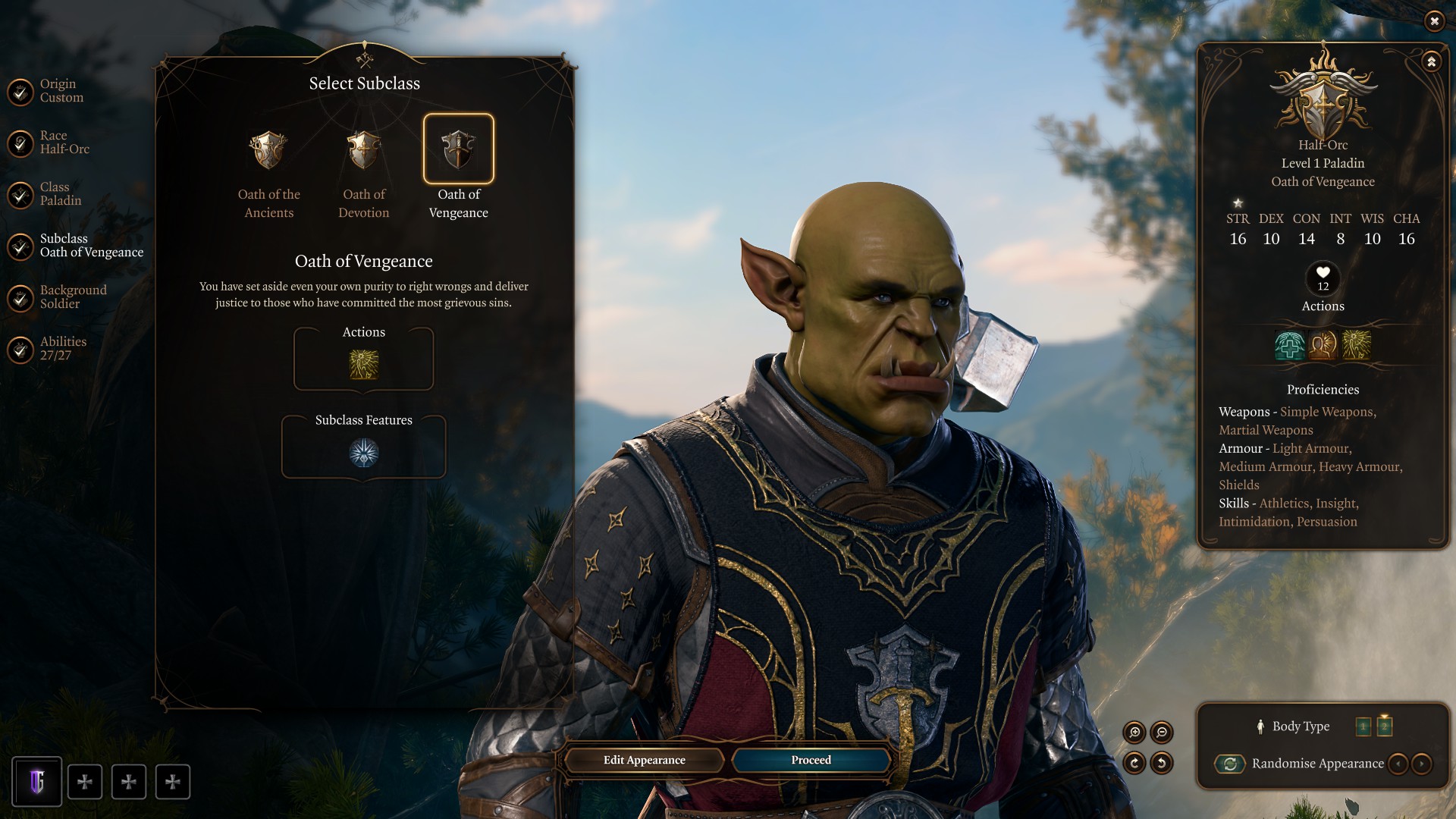
The Oath of the Vengeance subclass is the best for a Paladin on Tactician Difficulty because it has Misty Step for mobility and Inquisitor’s Might for bonus action utility. Additionally, Vengeance Paladin’s gain Hunter’s Mark and Relentless Avenger, giving you better bonus action usage and mobility.
Alternatively, you can use the Oathbreaker subclass. This subclass is more “evil” and will grant powerful bonuses as well, though lacking the mobility aspects of Vengeance. However, it can be helpful to use Oathbreaker if you frequently make bad decisions because you will default to this subclass and require gold to swap back. If you use Oathbreaker, most of this guide and level progression remain the same, with small changes to subclass-specific spells and passives.
Recommended Background for Paladin
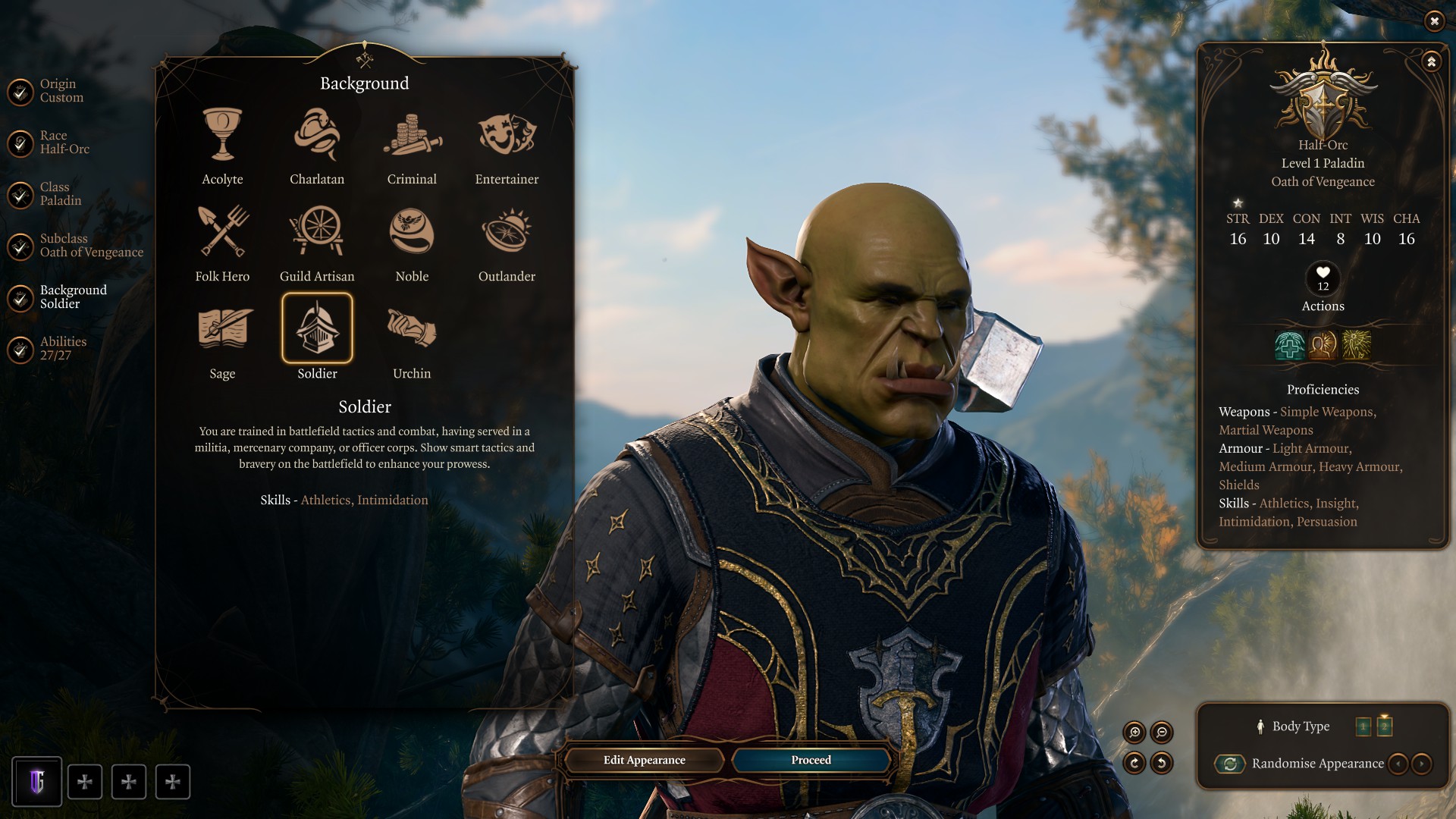
The best background for a Tactician Paladin build is Solider because it grants athletics and intimidation skills. Athletics is a helpful strength skill that prevents being shoved, and it is useful when playing a frontline melee build. Additionally, Intimidation is useful in dialogue, especially with the high charisma Paladin builds.
Ability Score

The Best Ability Score for Tactician Paladin Build is 16 Strength, 16 Charisma, and 14 Constitution. Strength will be your primary attribute due to melee damage with Greatswords and other weapons. Charisma will help influence dialogue and spells you cast as a Paladin. Constiution is your general health and concentration saving throw, which must also be high. Additionally, expect to go last in combat order due to low Dexterity. You can forgo the increasing strength feat at level 8 and take the Alert feat. This helps if you dread going last and constantly get crowd-controlled before your turn starts.
Below is the best ability score for a Tactician Paladin in Baldur’s Gate 3:
- Strength: 16
- Dexterity: 10
- Constitution: 14
- Intelligence: 8
- Wisdom: 10
- Charisma: 16
Additionally, you can have two skills as 8 and an odd number ability score. This is only useful if you commit to gaining the Act 1 Permanent bonus from Auntie Ethel. If you do not, this won’t be a good ability score setup. You can increase your ability score via a quest in Act 1, Act 2, and Act 3. Make sure to check out our Permanent bonus guide on how you can boost your ability score through quests.
Recommended Skills for Paladin
The best skills for a Paladin are Persuasion and Insight. These bonuses change depending on your Background, and with Soldier, you gain Athletics and Intimidation. If you choose a different background, make sure to gain Athletics instead of Insight.
Illithid Powers For Paladin
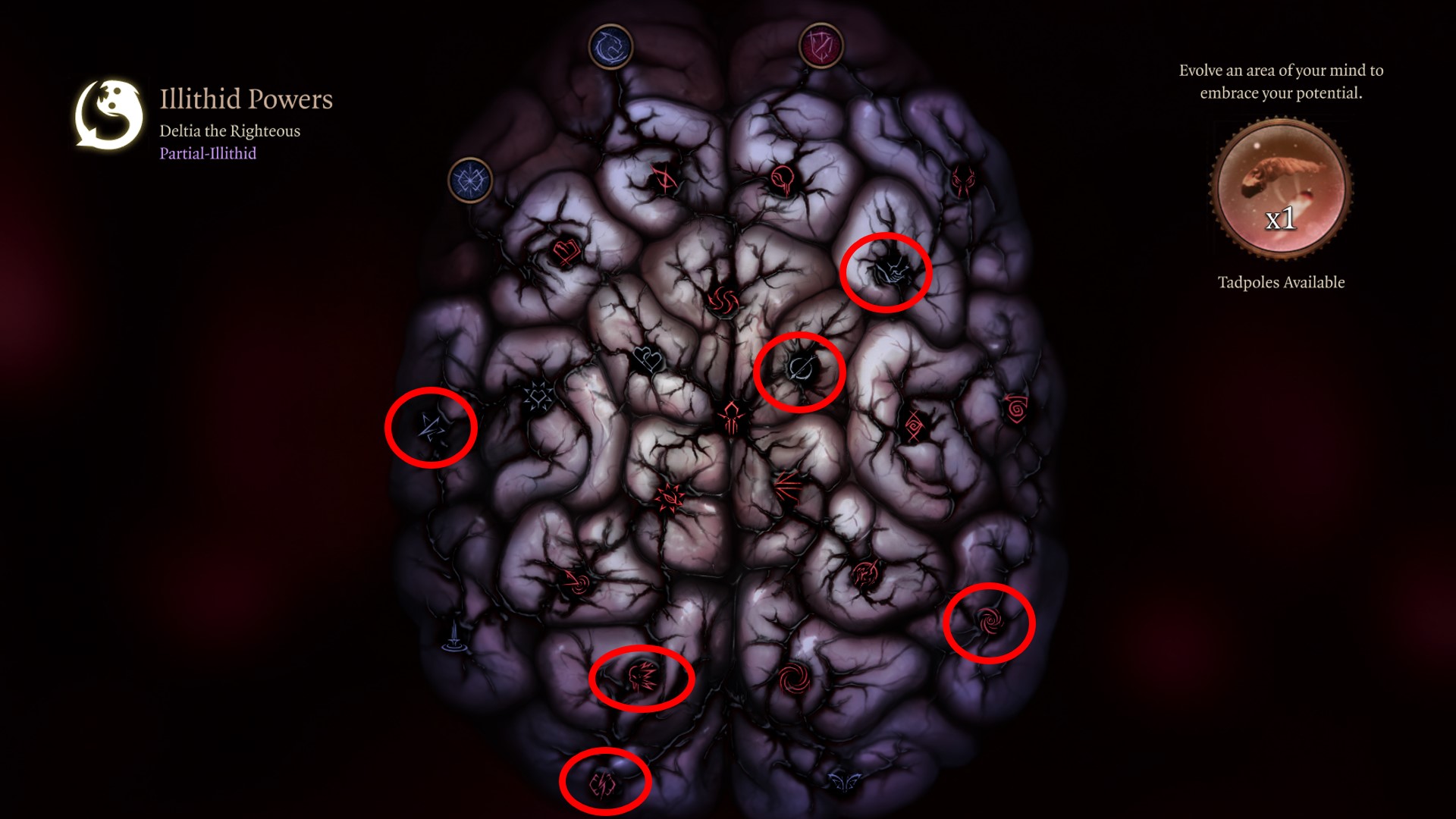
The best Illithid Powers for a Paladin build are Luck of the Farm Realms, Black Hole, and Cull of the Weak. Luck of the Farm helps with critical hits and burst damage and, combined with Cull of the Weak, can trigger AOE damage passively. Black Hole requires you to take the Astral Tadpole in Act 2, but it sucks in 5 enemies, slows them, and can be recast for free. This is helpful in certain large-scale boss fights with many enemies. Below are the best Illithid Tadpole Powers for the Paladin build in Baldur’s Gate 3:
| Illithid Powers | Description |
|---|---|
| Favourable Beginnings | The first Attack roll or Ability check you make against any target gains a bonus equal to your Proficiency Bonus. Helpful passively boosts damage based on your level. |
| Luck of the Far Realms | When you make a successful Attack Roll against a foe, you can change that hit into a Critical Hit. |
| Blackhole | Summon a black hole that pulls in up to 5 nearby enemies and potentially Slows them. Requires Displace or Psionic Dominance. |
| Cull of the Weak | When you bring a creature down to fewer hit points than your number of evolved Illithid powers, it dies and all nearby creatures take 1-4 Psychic damage. |
| Mind Blast | Spew forth a conical wave of psychic energy and possibly Stun targets within. Deals 4d8+Spellcasting Ability Modifier Psychic damage. It can be accessed by consuming astral-touched tadpoles. |
| Freecast | Spell slots, charges, and similar resource costs for your next action or spell are removed. Requires Shield of Thralls or Mind Sanctuary and used once per long rest. |
Best Paladin Tactician Build – Level Progression in Baldur’s Gate 3
| Level | Class | Selection |
|---|---|---|
| 1 | Paladin | Oath of Vengeance |
| 2 | Paladin | Fighting Style: Great Weapon Fighting Prepare Spells: Command, Thunderous Smite, Divine Favor, Heroism, Protection from Good and Evil |
| 3 | Paladin | Searing Smite |
| 4 | Paladin | Prepare Spell: Compelled Duel Feat: Great Weapon Master |
| 5 | Paladin | Aid |
| 6 | Paladin | Magic Weapon |
| 7 | Paladin | Lesser Restoration |
| 8 | Paladin | Feat: Ability Improvement Strength |
| 9 | Fighter | Fighting Style: Defense |
| 10 | Fighter | – |
| 11 | Fighter | Subclass: Battle Master Battle Manoeuvres: Precision Attack, Riposte, Trip Attack |
| 12 | Fighter | Feat: Ability Improvement Strength |
Alternative Tactician Build BG3
The Paladin multiclass with the Warlock gives you added range and more spell diversity. The Warlock Hexblade starts very powerful helping you deal with mobility issues in Act 1. Later on, you can add Eldritch Knight subclass and gain more spells and cantrips, completing a well rounded Paladin build capable of dominating Tactician mode.
| Level | Class | Selection |
|---|---|---|
| 1 | Warlock | Hexblade, Shield, Hellish Rebuke, Booming Blade, Eldritch Blast |
| 2 | Warlock | Wrathful Smite, Hex spells, One with Shadows, Devil’s Sight Invocations |
| 3 | Paladin | Multiclass Paladin, Vengeance Subclass |
| 4 | Paladin | Great Weapon Fighting, Command, Thunderous Smite, Divine Favour, Shield of Faith, Cure Wounds |
| 5 | Paladin | Protection from Good and Evil |
| 6 | Paladin | Great Weapon Master Feat, Compelled Duel |
| 7 | Paladin | Drop Compelled, select Magic Weapon, Lesser Restoration |
| 8 | Paladin | Aid spell |
| 9 | Fighter | Multiclass Fighter, Defense Fighting Style |
| 10 | Fighter | Action Surge |
| 11 | Fighter | Eldritch Knight subclass, Chromatic Orb, Magic Missile spells, Bursting Sinew, Fire Bolt cantrips, Longstrider extended |
| 12 | Fighter | Savage Attacker feat, Shield spell |
Level 1

At level 1 with a Tactician Paladin, select the character creation recommended background, race, skills, and ability score. You won’t have much unlocked, including spellcasting and Divine Smite, so get to level 2 as fast as possible. Your priorities are to acquire heavy armor and a two-handed weapon, the Greatsword. The first options are Everburn Blade, the Sword of Justice, and Silver Sword, all in Act 1. You can grab medium armor from Lae’zel in the introduction and remove her from your party after the prologue. Then look to access the Hollowed City at the north of the starting spot post tutorial where Dammon and others will sell good armor. Here’s what you unlock as a level 1 Paladin:
- Channeled Oath Charges: Paladin-specific resource that allows the casting of spells and abilities.
- Lay on Hands: Use your blessed touch to heal a creature or cure it of all diseases and poisons.
- Divine Sense: Gain Advantage on Attack Rolls against celestials, fiends, and undead.
- Inquisitor’s Might: You or an ally’s weapon attacks deal an additional 2 Radiant damage and can Daze enemies for 1 turn.
- Oath of Vengeance Tenets: No Mercy for the Wicked.
Paladin Gameplay
While this level doesn’t involve spellcasting and may seem underwhelming, it sets the foundation for a rapidly escalating power surge. For this build, prioritize acquiring five levels in Paladin initially. The primary reason for this is to secure the Extra Attack feature. This ability enables two attacks per turn, which, when coupled with Great Weapon Master and Divine Smite, unleashes immense damage potential. Later on, you can transition to the Rogue Thief combination for an additional bonus action. Then, finish with the Fighter Battle Master for action surge, the best strategy for the Best Baldur’s Gate 3 Tactician Paladin Build.
At this level, your primary focus is on familiarizing yourself with resources and skills. Channeled Oath Charges serve as your primary resource, primarily utilized for subclass abilities. Lay on Hands is an immensely valuable self-healing tool with associated charges. Your Oath determines your playstyle and subclass choice. If you deviate from your Oath, you can follow the Oathbreaker path outlined here. However, you can always return to the Vengeance Oath for 1,000 gold, so exercise caution in your dialogue choices and actions. Gameplay at this stage revolves around attacking, utilizing Lay on Hands for self-preservation, and preparing for the impending surge in power.
Tactician Paladin Priorities
Your overall priority with the Tactician Paladin build is the following:
- Act 1 Checklist for step-by-step completion
- Complete Prologue
- Recruit Companions
- Unlock Withers, respec companions to proper class/ability score
- Collect the Necromancy of Thay (important in Act 3)
- Reached Hollowed City/Druid Grove
- Sell, Stock up, complete quests
- Unlock summons, Scratch, Shovel
- Progress to level 5
- Reach Underdark and Grymforge
- Check all Permanent Bonuses in Act 1 and the best Gear
Level 2

The level two Tactician Paladin unlocks five spells, subclass spells, and Divine Smite. Additionally, select Great Weapon Fighting for your class bonus to help with melee weapon attacks. Here are the recommended spells and usage:
- Command: Command a creature to flee, move closer, freeze, drop to the ground, or drop its weapon. This is your single target stun ability which should only be used if its critical to stun a target vs attacking.
- Thunderous Smite: Using a bonus action and action, this spell does a smite that can knock enemies prone. Therefore, try to start combat by stealing and using Thunderous Smite. However, stay away from this ability unless you need a CC knockdown because it uses both action and bonus action.
- Divine Favour: uses bonus action to deal extra radiant damage and requires concentration. Helpful because it uses a bonus action and can boost damage early.
- Heroism: uses action and spell slots with concentration but protects against fright. It can be helpful in specific fights because you can pre-buff with it and still move when enemies try to stop you.
- Protection from Good and Evil: Protect an ally against the attacks and powers of Aberrations, Celestials, Elementals, Fey, Fiends, and Undead. This skill is useful in specific fights and requires concentration but last until long rest, so you can pre-cast it.
At this level mainly use melee attacks and equip a ranged heavy crossbow if possible to keep some type of damage at range. Look just to use Divine Smite when you can kill a target with extra damage, and conserve your spell slots.
Level 3

At level 3, the Tactician Paladin build receives many subclass actions and spells. You can take anything here to select your spell. Searing Smite is another okay spell that be helpful when a target is vulnerable to fire. Below is our recommendations at level 3:
- Divine Health: prevents the disease from affecting you (passive benefit).
- Abjure Enemy: Fight an enemy. They’ll be easier to hit and cannot move. Fiends and undead have Disadvantages on this Saving Throw. Helpful against fiends specifically.
- Vow of Enmity: Gain Advantage on Attack Rolls against an enemy. Niche usage against specific enemies.
- Bane: Up to 3 creatures receive a -1d4 penalty to Attack Rolls and Saving Throws. Not used on this build, waste a spell slot.
- Hunter’s Mark: Mark a creature as your quarry to deal an additional 1d6 Slashing Damage whenever you hit it with a weapon attack. If the target dies before the spell ends, you can mark a new creature without expanding a Spell Slot. Great debuff spell single target and you can reapply after a kill for free with a bonus action. It’s a super useful spell, but it requires a spell slot and concentration; therefore, it’s helpful later on. You can start turning one, casting this, and then attacking to do more passive damage. Additionally, Grym’s helm drops this, giving free use of the spell in Act 1.
Gameplay Tips at Level 3
At this level, you have a lot of flexibility with your spells, skills, and actions. The key is to use both your and bonus actions efficiently each turn. I avoid using Thunderous or Searing Smite often since they require both an action and a bonus action, which can be too costly. I usually cast a buff like Divine Favor or Shield of Faith on the first turn, followed by a melee attack. After that, I assess the situation: Command is a solid choice if I need to stun an enemy. Thunderous Smite is my go-to for high damage and a single-target stun. Generally, I focus on melee attacks and use Hunter’s Mark as my bonus action if my concentration spell (like Divine Favor or Shield of Faith) has worn off.
Even at level 3, playing a Paladin can be complex. Start by buffing on turn one, then focus on burst damage on turn two. By turn three, reassess your party’s needs—crowd control, burst damage, healing, etc. Repeat this pattern until you unlock more spell slots. Don’t forget to check if you’ve used your bonus action before ending your turn. Casting Hunter’s Mark or Divine Favor can be crucial if you have spell slots available.
Level 4
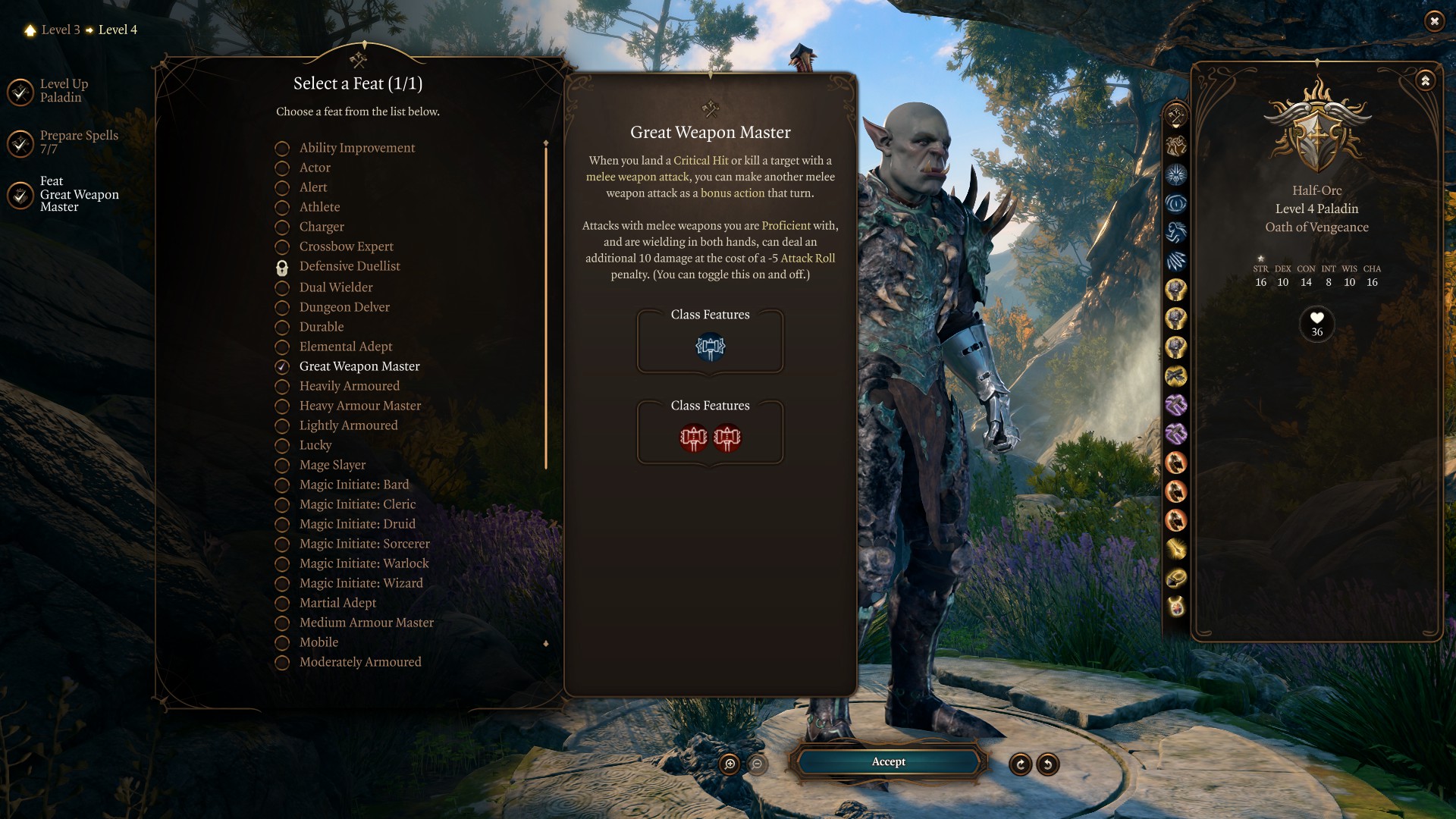
At level four, you gain your first feat, and we recommend a great weapon master. This feat gives you a negative penalty to attack rolls, meaning your percentage chance to hit will decrease. However, you will gain a +10 damage, giving the build a risk and reward. Moreover, if you kill or critical hit, you can attack with a bonus action, gaining even more utility.
Alternative feats here are +2 Strength to keep the build simpler or Alert to go earlier in combat. Laster in levels, you can take another +2 Strength or Savage Attacker. Also, consider how frequently you use Elixir or Strength, which will increase you to 21 STR passively.
For spells, Aid is helpful because you can pre-buff with it and increase the spell slot and max HP.
Level 5

At level 5, you gain Extra Attack, Hold Person, Misty Step, and another spell slot. Misty Step is your mobility tool with a bonus action. Hold Person isn’t effective because you have Command for a crowd control skill, and Hold Person requires concentration. Extra Attack means each action gives you two attacks, so expect your power to increase. Another spell choice here is Compelled Duel or Aid, which are good options.
Additionally, we recommend continuing to level with the Paladin and not multiclass. This will keep things less complex and give you more spell slots so you don’t have to rest for long after every fight.
Level 6
At level 6, you gain one spell slot, and we recommend Magic Weapon. It’s another useful spell to buff damage while holding concentration. However, you have many tools and skills to do this, therefore save your bonus action and concentration typically for Hunter’s Bane.
Level 7

At level 7, take the Lessor Restoration spell. This can be helpful in rare circumstances where an ally is poisoned. Most of the spells in the Paladin’s kit aren’t applicable to melee damage builds and are slotted and used on rare occasions. Therefore, don’t feel you must select, use, or even fuss with spells beyond an occasional pre-buff skill.
Level 8

At level 8, you gain another prepared spell and a feat. For feat recommendations, +2 Strength is the best if you took Great Weapon Master at level 4. Ideally, you want to reach 20 strength or use the Elixir of Strength after every rest. Then, you can take Alert or Savage Attacker. Alert is more defensive and helpful in Act 2 when surprised in combat. Savage Attacker with Half-Orc is the most burst feat when using the melee build.
Level 9
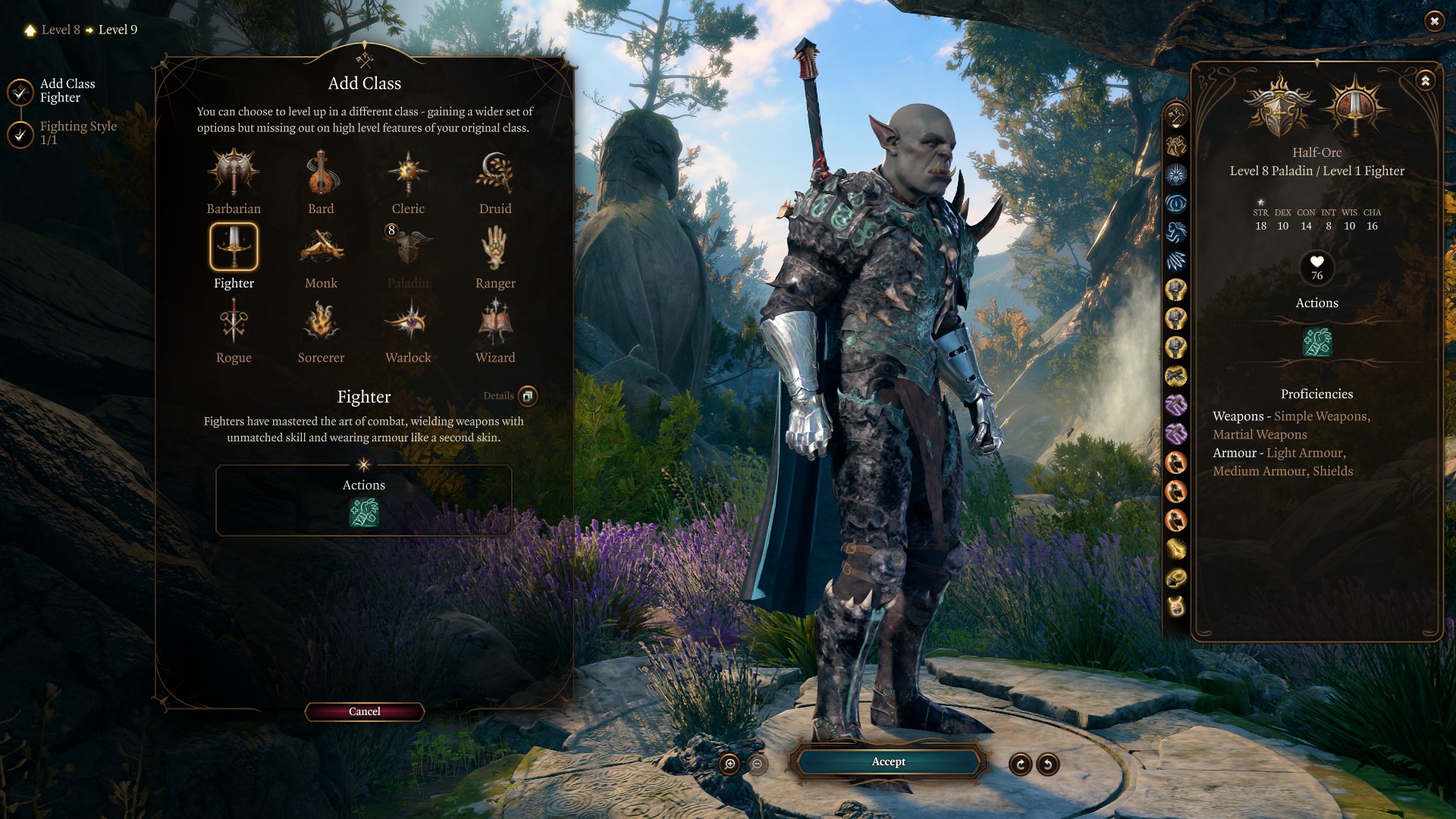
At level 9, you should multiclass the Tacitican Paladin build to the Fighter Class. This helps give you a well-rounded build, along with Action Surge and Defence Fighting Style. Select Defence Fighting Style at this level to passively boost your AC and increase survivability.
Another multiclass alternative is Rogue and then Thief to gain an additional bonus action. However, if you do not multiclass, the build power will fall off, and you miss out on blending the best parts of Paladin and Fighter.
Level 10
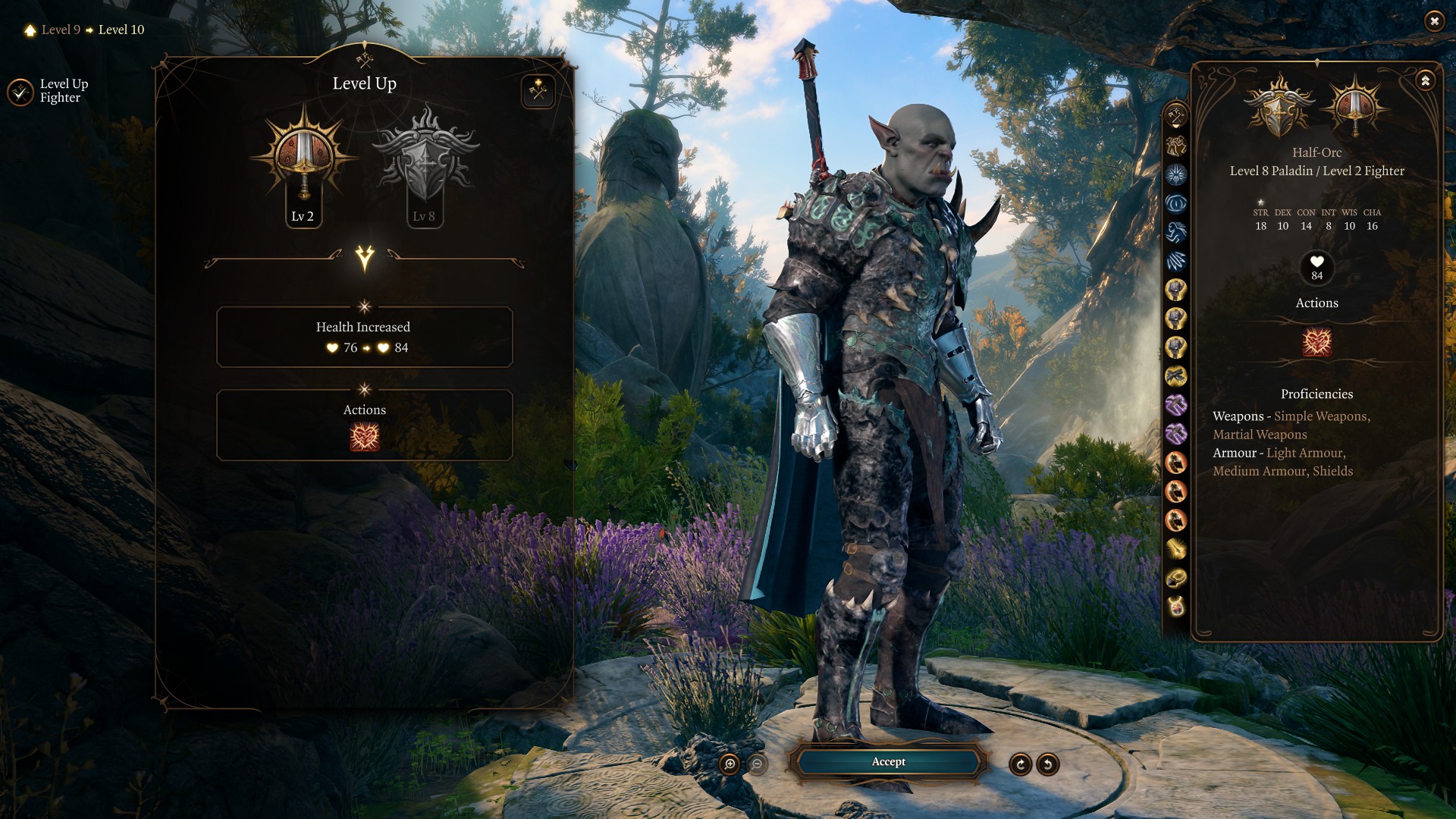
Your second level into the Fighter as a multiclass Paladin grants Action Surge. This is a once-per-short-rest skill that grants another action. With Extra Attack, you can attack four times on your first turn. Additionally, if you kill a target or critically hit, you gain another attack with Great Weapon Master, making it five. What makes this even more powerful is that you can trigger Divine Smite for even more damage with each attack. You will consume many spell slots, but one turn at this level can destroy a boss solo.
Level 11

At level 11, with a third level into Fighter, select the Battle Master subclass. This subclass gives you a new resource called maneuvers. Select Precision Attack for extra damage passively. Riposte is helpful when fighting on the front lines and returning damage passively. Lastly, Trip Attack gives you an on-demand stun that only requires a resource and not a bonus action like Thunderous Smite.
Additionally, these maneuvers can be used with a normal main-hand attack and Divine Smite proc. Therefore, they are used at the start of combat to burst down enemies and stun them.
Level 12

You’ve reached the final level in Baldur’s Gate 3, 12! Select ability improvement Strength +2 to reach 20. If you obtain the Gauntlets of Strength, you can respec at Wither’s your Strength to 8, then increase Dexerity and take Alert, Great Weapon Master, and Savage Attacker feats.
Best Companions for Paladin
Shadowheart, Gale, and Lae’zel make the best companions for the Tactician Paladin build, because you gain Intelligence Wizard, Wisdom Cleric, then a powerful race in the Githyanki. We recommend respecing Shadowheart to Life Cleric build so she can have the most powerful buffs and healing in BG3 and help with crowd control. Gale performs as an Evocation Wizard, providing AOE damage and intelligence-based skills. Lastly, Lae’zel is your flex character. Ideally, we respec her to Gloom Stalker Ranger, giving you a big edge on turn one. Recommended Companion builds:
- Shadowheart (Cleric / Life)
- Gale (Wizard / Evocation)
- Lae’zel (Ranger / Gloom Stalker)
Best Gear for Paladin Build
Beginner
Here’s the best beginner gear, items, and equipment for Tactician Paladin Build in Baldur’s Gate 3:
| Gear Slot | Best Gear Item | Effect |
|---|---|---|
| Head | Helmet of Smiting | Smite gives HP |
| Cape | – | |
| Chest | Adamantine Splint Armour | 18 AC |
| Gloves | Gloves of the Growling Underdog | Advantage on Melee |
| Boots | Disintegrating Night Walkers | Free Misty Step |
| Necklace | Moondrop Pendant | No Opportunity Attacks |
| Ring | Crusher’s Ring | Increase Movement |
| Ring | Caustic Band | Poison Damage |
| Weapon 1 Main Hand | Sword of Justice | 2d6 Slashing |
| Weapon 2 Ranged | Bow of Awareness | +1 Initiative |
- Bow of Awareness: Sold by Vendor Roah Moonglow in the Shattered Sanctum (Alternatives Hunting Shortbow, Bow of Banshee, Titanstring Bow).
- Helmet of Smiting: Located in Underdark Selûnite Outpost (Alternatives Haste Helm, Cap of Wrath, or Grymskull Helm).
- Deathstalker Mantle: Automatically acquired as part of Dark Urge story.
- Adamantine Splint Armour: Crafted in Adamantine Forge (Alternatives Chain Mail +1, or Githyanki Half Plate).
- Gloves of the Growling Underdog: Chest behind Razglin’s throne room (Alternatives Gloves of Heroism, Gloves of Dexterity, or Gloves of Missile Snaring).
- Disintegrating Night Walkers: Obtained in Gyrmforge as part of Free True Soul Nere questline (Alternatives Boots of Striding, Boots of Genial Striding, or Boots of Speed).
- Moondrop Pendant: Sealed chest inside the Owlbear Nest (Alternatives Amulet of Branding, Amulet of Misty Step, or Amulet of Restoration).
- Crusher’s Ring: Can be looted or stolen from Crusher in the Goblin camp (Alternatives Strange Conduit Ring, or Ring of Absolute Force).
- Caustic Band: Obtained from merchant Derryth Bonecloak in the Myconid Colony (Alternatives Fetish of Callarduran Smoothhands, or The Sparkswall).
- Sword of Justice: Looted from Anders near Karlach (Alternatives Jorgoral’s Greatsword, Silver Sword of the Astral Plane, or Everburn Blade).
Advanced
The following table presents the best gear, items, and equipment for the Tactician Paladin Build in Baldur’s Gate 3:
| Gear Slot | Best Gear Item | Effect |
|---|---|---|
| Head | Helm of Balduran | Self-healing |
| Cape | Fleshmelter | Return Damage |
| Chest | Helldusk Armour | 21 AC |
| Gloves | Legacy of the Masters | +2 Attack rolls |
| Boots | Helldusk Boots | Mobility |
| Necklace | Amulet of Greater Health | 23 Constitution |
| Ring | Killer’s Sweetheart | Auto Critical |
| Ring | Ring of Regeneration | Self-healing |
| Weapon 1 Main Hand | Balduran’s Giantslayer | Best Greatsword |
| Weapon 2 Ranged | Darkfire Shortbow | Gives Haste |
Below is the best Act 3 Armor, Weapons, and Equipment for Tactician Paladin build in BG3:
- Helm of Balduran: Obtained in Dragon’s Sanctum (Alternatives Helldusk Helmet, Sarevok’s Horned Helmet, Mask of Soul Perception).
- Fleshmelter: Found in Chest in House of Healing Morgue (Alternative Cloak of Protection).
- Helldusk Armour: Dropped by Raphael in the House of Hope (Alternatives Armour of Devotion, Armour of Persistence, Bhaalist Armour).
- Legacy of the Masters: Purchased from Dammon in Lower City Baldur’s Gate (Alternatives Gauntlets of Hill Giant Strength, Helldusk Gloves, Gloves of Soul Catching).
- Helldusk Boots: In a locked chest, Wyrm’s Rock Fortress (Alternative Disintegrating Night Walkers).
- Amulet of Greater Health: Found in the House of Hope in Baldur’s Gate City (Alternative Surgeon’s Subjugation Amulet, or Periapt of Wound Closure).
- Killer’s Sweetheart: Obtained from the Gauntlet of Shar in Act 2 (Alternative Ring of Protection, Risky Ring).
- Ring Of Regeneration: Sold by Rolan at Sorcerous Sundries (Alternative Ring of Free Action, Shifting Corpus Ring).
- Balduran’s Giantslayer: Obtained as a reward for completing the Wyrmway trials (Alternatives Sword of Chaos, Silver Sword of the Astral Plane).
- Darkfire Shortbow: Sold by trader Damon Act 2 Last Light Inn (Alternative Fabricated Arbalest).
Best Consumables, Potions, Ammunition, and Items
The following list is the best consumable items that will aid in our Paladin Tactician Build Guide:
- Elixir of Bloodlust: Once per turn when you kill a foe, you gain HP 5 temporary hit points and an additional action.
- Elixir of Hill Giant Strength: Increases Strength ability score to 21 until Long Rest.
- Potion of Speed: Gain extra action, +2 AC, Advantage on Dexterity Saving Throws, and double movement speed.
- Drow Poison: Weapon poison that adds Constitution Saving Throw or becomes Poisoned and falls Asleep.
- Potion of Flying: Drink to gain a flying speed of 60ft for one hour.
- Elixir of Heroism: Gain 10 temp HP and become Blessed until a long rest.
- Potion of Greater Healing: 4d4 + 4 hit points restored.
- Oil of Accuracy: Coat Weapon. Bonus of +2 in Attack Rolls.
- Elixir of Vigilance: Drink to gain a +5 bonus to Initiative and you can’t be Surprised.
Permanent Bonuses
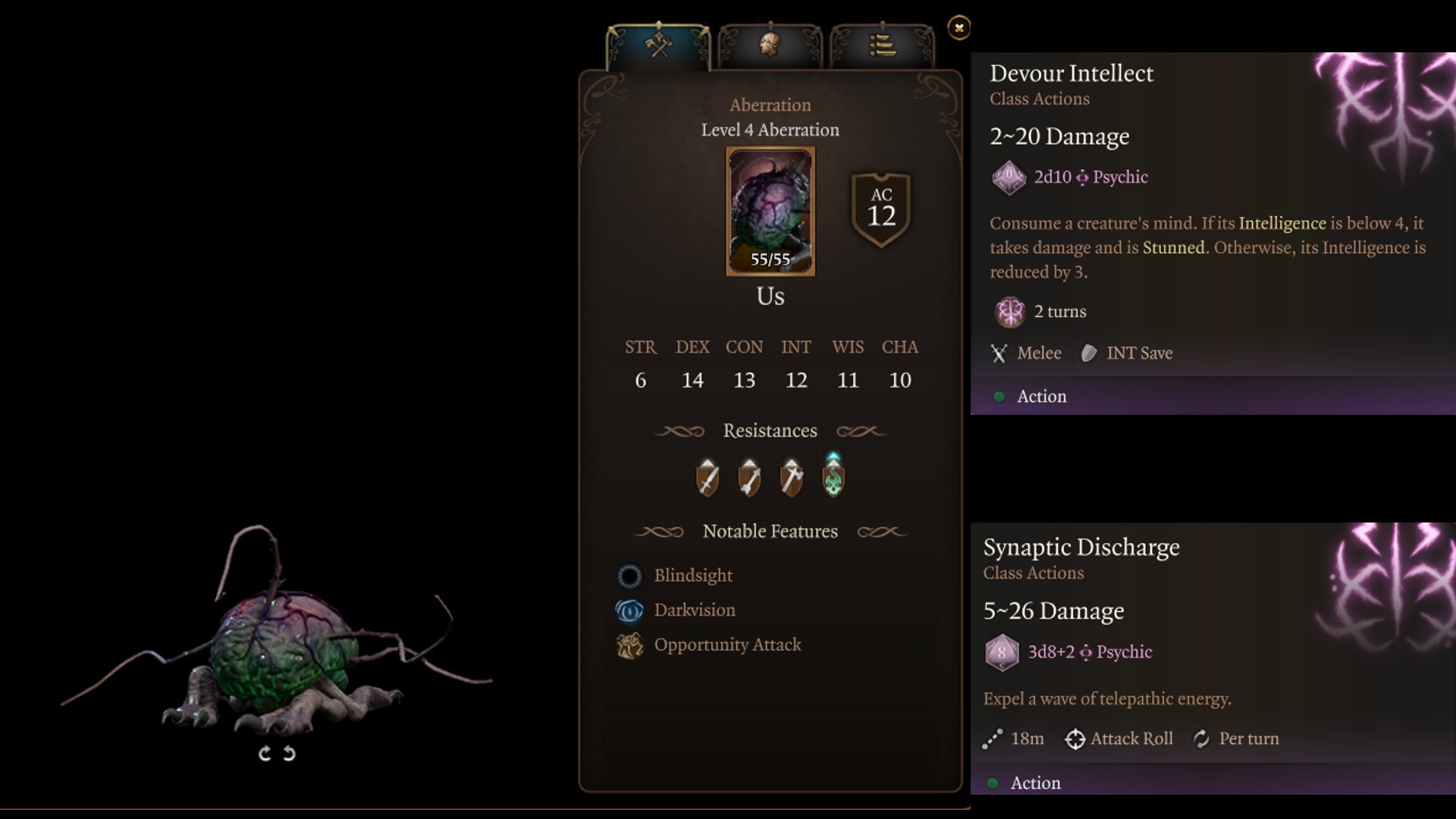
Throughout Baldur’s Gate 3, you will have the ability to gain permanent bonuses to your character. These can grant additional spells, ability scores, and other bonuses. Permanent Bonuses are not displayed throughout the campaign but are vital to increase combat performance. We have all permanent bonuses here in a guide, but the most important ones for you to collect are listed below.
| Act 1 | Act 2 | Act 3 |
|---|---|---|
| Auntie Ethel’s Hair: Gain +1 to an Ability Score. | Potion of Everlasting Vigour: Gain +2 Strength. | Mirror of Loss – +2 to an Ability Score of your choice. |
| Awakened: Use illithid powers as a Bonus Action. | Slayer Form: Ability to transform into the Slayer. | Partial Ceremorphosis: Access to tier 3 illithid Powers. |
| Scratch: Gain Find Familiar Scratch. | Summon Us: Allows you to summon Us. | Sweet Stone Features: Blessed permanent. |
| Cheeky Quasit: Gain Summon Quasit Shovel. | Statue of the Gods: +2 to Saving Throws | |
| Loviatar’s Love: 30% Hit Points or less, you gain a +2 bonus to Attack Rolls and Wisdom saving throws. | ||
| Necromancy Of Thay: access to powerful spells in Act 3. | ||
| Volo’s Ersatz Eye: See Invisibility |
Build Summary – Best Baldur’s Gate 3 Tactician Paladin
Classes: Paladin, Fighter
- Oath of Vengeance
- Battle Master
Armor: Heavy
Weapons: Greatsword
Race: Half-Orc
Ability Score
- Strength: 16
- Dexterity: 10
- Constitution: 14
- Intelligence: 8
- Wisdom: 10
- Charisma: 16
Level Progression
- Level 1: Half-Orc, Soldier, Persuasion
- Level 2: Great Weapon Fighting
- Level 3: Searing Smite
- Level 4: Great Weapon Master
- Level 5: Aid
- Level 6: Magic Weapon
- Level 7: Lessor Restoration
- Level 8: +2 Strength Feat
- Level 9: Multiclass Fighter
- Level 10: Action Surge
- Level 11: Battle Master Subclass
- Level 12: +2 Strength Feat
Looking For More About Baldur’s Gate 3?
Thank you for reading the Best Baldur’s Gate 3 Tactician Paladin Build Guide. We provide the latest news and create guides for Baldur’s Gate 3. Also, watch me play games on Twitch or visit my YouTube channel!
 Reddit
Reddit
 Email
Email
